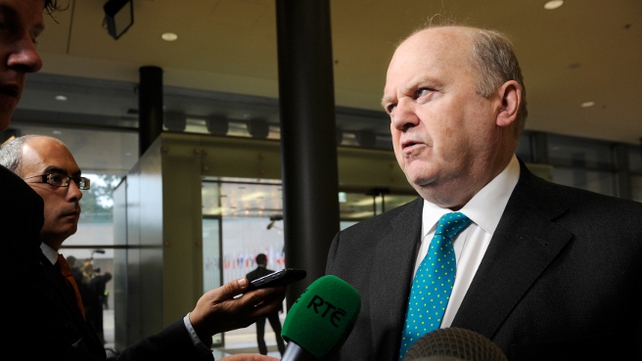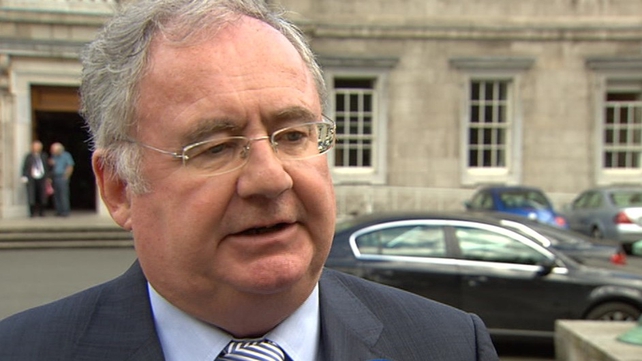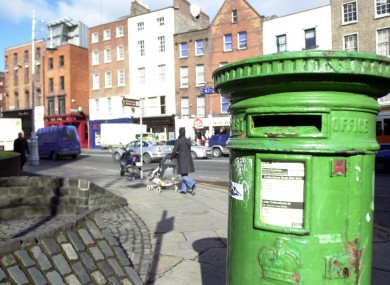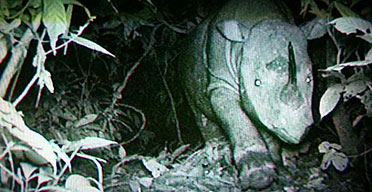Michael Noonan confirms Irish budget will take €2.5bn out of the economy
RUAIRÍ QUINN SAYS ‘ANY ROOM TO MANOEUVRE’ SHOULD BE USED TO STIMULATE THE ECONOMY
Minister for Finance Michael Noonan speaking to reporters at the Global Irish Economic Forum at Dublin Castle on Friday.
The forthcoming budget will be see spending cuts and tax increases totallying €2.5billion, Minister for Finance Michael Noonan confirmed this morning.
The adjustment, and not as much as an anticipated €3.1billion, is the amount of money the Government needs to take out of the economy in 2014 to meet strict bailout targets set by the State’s trokia of lenders.
Mr Noonan’s comments indicate the Government now has to find up to €600m less than expected on October 15th to meet the targets and run the country in 2014.
Speaking on his way into a pre-budget Cabinet meeting this morning he said “we can achieve our targets by not going the full way to €3.1billion because there are other savings in the system “.
Mr Noonan said these savings could be “reckoned as part of the adjustment”.
“If you simply add the spending cuts to the tax increases if comes in slightly ahead of two-and-ahalf billion”.
Also speaking as he arrived for the Cabinet meeting Minister for Education Ruairí Quinn said he agreed with Siptu’s Jack O’Connor that “if we have for room to manoeuvre we should do it to stimulate the economy.” He said he agreed there was a need to focus on job creation innext week’s Budget.
But in regard to the necessary cuts in Government spending he said a balance needed to be struck.
“I think we’re in the middle of a recovery process, it’s not easy, everybody is suffering to a certain extent”. He said the Government’s aim was to “try and minimise the suffering as quickly as we can” .
Speaking earlier this morning on RTÉ’s Morning IrelandSiptu’s Jack O’Connor said any room to manoeuvre in the Government finances should be used to stimulate job creation and protect those on social welfare.
Mr O’Connor was responding to overnight reports that a Budget package based on the reduced €2.5 billion adjustment, was all but agreed between the Government parties.
According to reports the Fine Gael and Labour ministers were about to agree a Budget which would include cuts in social welfare, school class sizes and GP care , among others.
Mr O’Connor said the Government should be taking the minimum out of the economy to comply with the requirements of the bailout.
He said the only way to achieve the ultimate deficit target of 3 per cent of GDP by 2015 was to increase the size of the economy by about €13 billion by then.
He said this could not be achieved if domestic demand continued to be suffocated.
He said the Government had to find some way to put money into the economy, as “if you are depressing three quarters of the economy you are not going to get out of this mess”.
He said Siptu, as the State’s largest trade union, would propose pay rises right across the economy if the Government exceeds its target of reducing the budget deficit to 5.1 per cent of GDP for next year.
EURO MEPs tighten anti-tobacco laws aimed at young smokers


Euro MPs have voted to tighten tobacco regulations aimed at putting young people off smoking, but some measures do not go as far as originally planned.
They rejected a European Commission proposal to treat electronic cigarettes as medicinal products – a move that would have restricted sales.
They backed a ban on cigarette flavourings – but with a five-year delay in the case of menthol.
Slim cigarettes will not be banned. EU ministers must now consider the plans.
Among other measures, MEPs voted on Tuesday to put health warnings on 65% of each cigarette pack, as opposed to the proposed 75%.
Linda McAvan, the Labour MEP steering the legislation, said 65% was still “a long way towards plain packaging”.
The current requirement for health warnings is for 30% minimum coverage on one side and 40% on the other.
Packs of 10 cigarettes, considered popular among younger smokers, will also be banned.
Fourteen EU states already have 20 as the minimum, four stipulate a minimum of 19, and in the UK and Italy the minimum is 10.
Smaller than normal packs of roll-your-own tobacco will still be allowed under the new rules.
It was the European Parliament’s first reading of a draft tobacco directive which could become law in 2014. It would then take two more years to become law in each of the 28 EU member states.
There has been intense lobbying of MEPs by the tobacco industry and health campaigners.
The Commission says almost 700,000 Europeans die from smoking-related illnesses each year – equal to the population of Frankfurt or Palermo. The costs for healthcare in the EU are estimated to be at least 25.3bn euros (£20.6bn; $33.4bn) annually.
Mixed reactions
Conservative and Liberal MEPs welcomed the amendments made to the original proposal from Labour’s Linda McAvan.
Speaking to the BBC, Ms McAvan said she was disappointed that slim cigarettes were not banned.
But cigarette packaging made to look like lipstick or perfume containers – attractive to girls – will disappear, she noted.
There will now be further negotiations with the Council – the grouping of relevant EU ministers. MEPs may manage to avoid a second vote and fast-track the legislation so that it is adopted before the May 2014 European elections.
The proposals also include a ban on words like “light”, “mild” and “low tar”, deemed to be misleading, and a ban on oral tobacco – called snus – although Sweden would retain its exemption.
EU Health Commissioner Tonio Borg called the vote “positive”. “I am confident that the revised Directive on Tobacco Products can still be adopted within the mandate of the current Parliament,” he said.
But Carl Schlyter MEP, health spokesman for the Greens, called it “a shameful day for the European Parliament, as a centre-right majority, led by the EPP group, has done the bidding of the tobacco industry and voted for weaker rules”.
Computer users lose 5 days a year due to slow loading start-ups

Computer users lose more than five-and-a-half days a year to slow-loading computers, applications, and files.
That is according to a study of PC and laptop users, which found slow computers are causing almost one-third of people to be put in a bad mood for the rest of the day. Some 17% have relieved their frustration over a gadget through physical aggression by either throwing it against a wall or stamping on it.
According to the study, by flash memory firm SanDisk, computer users in Britain last year lost over 130 hours of free time to slow loading computers, apps, and files.
With the typical desktop or laptop user waiting an average of up to 12 minutes for their machine to load at any one time, PC slowdowns have become one of the top seven most stressful everyday experiences, according to the study.
So-called digital downtime has climbed into the top seven, with a quarter putting the experience on a par with waiting for the boiler to be fixed.
The list includes waiting for a bus or train, and waiting for a non-reserved table at arestaurant.
Stefan Kratzer of SanDisk said: “PC users are spending too much time waiting for computers and would quite understandably like to get more time back to do the things they enjoy.
“It’s high time PC users started getting back the time they are losing to slow computers.”
All of Ireland’s addresses to have new postcode’s by 2015
D4 may become D04 under system which will use a seven-character “unique identifier” for every address
The Republic is to have a new postcode which will identify every home or commercial unit in the State , is has been announced.
The “world’s first” individual unit locator goes beyond the usual area codes in most developed countries, and will be a “unique identifier” with benefits for the postal and ambulance services, the Government has said. Most countries in the developed world have had post codes since at least the 1990s.
An award of a tender to a consortium headed by CapitaIreland was approved by the Government at a Cabinet meeting this morning.
The new postcode will comprise seven digits providing a unique identification for every letter box in the State. The “unit specific” code will be in the format A65 B2CD with the first three digits relating to the postal district.
It will be made available to the makers of satellite navigation systems and other businesses such as online route planners and shopping services, with the potential to make postal services, journey planning and web-based supermarket shopping more efficient.
Confirming that Ireland will be the first State in the world “to have a public database of unique identifiers” Minister for Communications Pat Rabbitte said the change would assist citizens, public bodies and businesses to locate every individual household in the State.
The department said the postcode will be a seven character code in the format A65 B2CD, with the first three characters relating to a general area or postal district in which the address is located.
A spokesman said important knowledge of locations will be retained in the new addresses. For example Dublin 4, and other existing postal districts in the Capital, will still be identifiable in the first three digits of the new code.
Existing Dublin postal districts will appear as the first three characters of the new postcode. “If you were D4, you might now be DO4 the spokesman explained in answer to a question from The Irish Times.
While it is a world’s first in terms of uniquely identifying every letterbox, the new system will bring Ireland in line with other European countries where postcode systems have been in use for many decades, Mr Rabbitte said. It is scheduled to be operational in Spring 2015,
Mr Rabbitte said there would be many benefits of the new system,” for example, given the prevalence of satellite navigation systems in cars, a driver will simply be able to insert a postcode into their device, rather than a lengthy address and will be provided with the accurate location”.
Householders will be informed of their postcode in early 2015 and will be able to use it from then on. Mr Rabbitte said “in the meantime the groundwork designing the code and updating private and public sector databases to accommodate the new postcode system will be undertaken.
The Capita consortium is expected to operate the postcode under licence for an initial ten year period extendable at the discretion of the Minister for Communications by a further five years.
Trinity scientists discover how huge sun storms knock out mobile phones
TRINITY COLLEGE dublin SCIENTISTS HAVE HELPED IDENTIFY A LINK BETWEEN SOLAR STORMS AND LOST CALLS ON MOBILE PHONES.
Massive explosions of hot gas on the sun give off radio bursts with the potential to affect satellites and mobile networks.
On August 21, Nasa said the sun fired off an intense storm, hurtling billions of tons of charged particles towards Earth at 380 miles per second.
“These particles cannot harm humans, but they can affect electronic systems in satellites and on the ground,” Nasa officials revealed at the time.
Scientists from Ireland, England and the US have been monitoring this process using a range of equipment, including a radio observatory at Birr Castle in Co Offaly.
They discovered that solar storms create huge shockwaves that race through the solar atmosphere at millions of kilometres an hour.
This leads to the acceleration of electrons, which in turn creates huge amounts of energy and radio waves.
The results were published in the online edition of Nature Physics.
“What we have found is fascinating – a real insight into how solar radio bursts is created,” Professor Peter Gallagher, solar physicist at Trinity College’s School of Solar Physics, told RTE.
“Using antennas at Trinity’s Rosse Observatory in Birr Castle together with images from NASA’s STEREO and Solar Dynamics Observatory spacecraft, we have identified a missing link between solar storms and radio bursts,” he added.
Elusive Sumatran rhino caught on camera in Borneo
A Sumatran rhino, thought to be extinct in eastern Borneo, has been caught on camera in the rainforest.
Hidden cameras have captured images of the critically endangered Sumatran rhino on the Indonesian part of Borneo island, where it was thought to have long ago died out, according to the World Wildlife Fund for Nature (WWF).
Sixteen camera traps — remote-controlled cameras with motion sensors frequently used in ecological research — filmed the rhino walking through the forest and wallowing in mud in Kutai Barat, East Kalimantan province.
The footage, filmed on June 23, June 30 and August 3, is believed to show different rhinos although the WWF said confirmation of this will require further study.
There were once Sumatran rhinos all over Borneo but their numbers have dwindled dramatically and they were thought to now exist only on the Malaysian part of the island.
But the research disclosed Wednesday, a joint effort between the WWF and authorities in Kutai Barat, shows that the animal is still present on the Indonesian side of Borneo.
There are estimated to be fewer than 275 Sumatran rhinos remaining in the wild, according to the International Union for Conservation of Nature (IUCN).








No comments:
Post a Comment